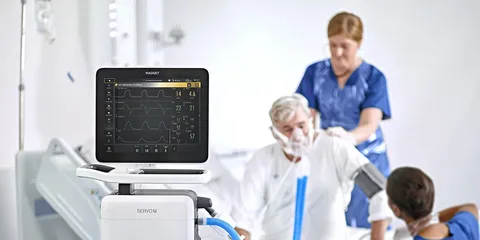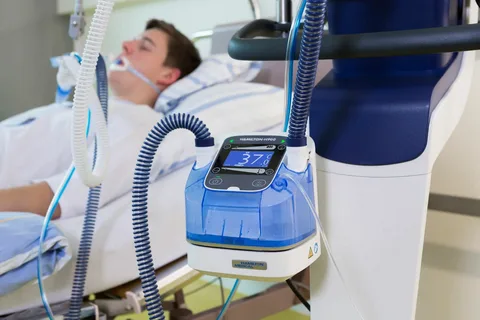In today’s world, where energy efficiency and environmental concerns are at the forefront of many conversations, mechanical ventilation has emerged as a modern solution for increasing building efficiency. Mechanical-ventilation systems are crucial in ensuring proper air circulation and indoor air quality. In this blog post, we will explore the importance, components, efficiency, benefits, and impact of mechanical-ventilation systems and discuss the costs and return on investment. We will delve into future trends in mechanical-ventilation technology.
Understanding Mechanical-ventilation and Its Importance
Mechanical-ventilation stands as a cornerstone in modern building design, emphasizing the pivotal role of indoor air quality in our health and environmental impact. By harnessing mechanical means to control the flow of air, this system is crucial in ejecting stale, polluted indoor air and introducing fresh, clean outdoor air into the interior space. Such a continuous exchange is vital in reducing the presence of airborne contaminants, including dust, allergens, and volatile organic compounds (VOCs), which can negatively affect respiratory health and overall well-being.
The essence of mechanical-ventilation lies in its ability to manage and optimize indoor environmental conditions, safeguarding occupants from the risks associated with poor air quality, such as asthma, allergies, and other respiratory issues. Moreover, this system is instrumental in mitigating moisture accumulation, thus preventing the proliferation of mound and mildew that can cause structural damage and health problems.
Beyond health benefits, mechanical-ventilation systems represent a critical step towards sustainability. By efficiently managing air exchange, these systems reduce the dependency on heating and cooling units, leading to significant energy savings and a decrease in the carbon footprint of buildings. In essence, the adoption of mechanical-ventilation is not just about enhancing indoor air quality; it’s about promoting a healthier, more sustainable way of living and working.
 The Components of Mechanical-ventilation Systems
The Components of Mechanical-ventilation Systems
The intricacies of mechanical-ventilation systems are defined by their essential components, each playing a specific role in ensuring the efficacy and efficiency of air movement within a space. At the heart of these systems are the fans, which propel air in and out of the building, establishing a consistent flow of fresh air and expelling stale, polluted air. This exchange is critical for maintaining optimal indoor air quality and comfort levels.
Ductwork is the circulatory system of mechanical-ventilation, channeling air throughout the premises. Its design and layout are meticulously planned to ensure even air distribution, minimising stagnation areas and ensuring every corner of the space is reached. Filters are another crucial component, purifying the air by capturing dust, allergens, and other airborne particles before entering the indoor environment. The quality and type of filter directly impact the system’s ability to improve air quality and protect the health of occupants.
Controls are the brains of the operation, allowing for precise regulation of the system based on various parameters, such as air quality levels, humidity, and temperature. Modern systems often feature sophisticated controls that can automate adjustments, optimizing performance and energy use. Together, these components form a comprehensive system designed to enhance indoor air quality, offering a seamless solution to air management challenges in both residential and commercial settings.
The Efficiency of Mechanical-Ventilation Systems
Mechanical-ventilation systems are engineered to be highly efficient, leveraging advanced technologies and design principles to ensure that air quality is maintained without excessive energy consumption. A vital feature of these systems is their ability to operate on demand, utilizing sensors and intelligent controls to detect when air quality levels necessitate intervention. This targeted approach means that energy is not wasted on unnecessary ventilation, which can significantly reduce overall energy usage compared to traditional systems that may operate continuously regardless of actual need.
Another aspect contributing to the efficiency of mechanical-ventilation systems is their role in heat recovery processes. Many modern systems are equipped with heat recovery ventilators (HRVs) or energy recovery ventilators (ERVs) that capture heat from outgoing stale air and warm incoming fresh air during colder months. Conversely, in warmer climates, these systems can help expel excess heat from indoor spaces, reducing reliance on air conditioning units and lowering energy costs.
The strategic placement of vents and the careful design of ductwork ensure that air is distributed evenly throughout the space, eliminating hot or cold spots and facilitating a more comfortable environment with less energy. When properly installed and maintained, the efficiency of these systems translates into lower utility bills, contributing to the economic sustainability of the building and enhancing the comfort of its occupants without compromising on air quality or environmental responsibility.
The Benefits of Mechanical Ventilation in Residential Settings
Mechanical ventilation systems provide an advanced solution for enhancing indoor living conditions. Utilizing state-of-the-art technology, they effectively manage the quality and flow of indoor air, boosting residents’ comfort, health, and well-being while providing notable energy efficiency.
Improved Air Quality
Mechanical-ventilation systems filter out pollutants, allergens, and contaminants, ensuring that the indoor environment is healthier for residents. This particularly benefits individuals with allergies, asthma, or other respiratory conditions.
Consistent Indoor Comfort
These systems regulate and maintain a steady fresh air flow, eliminating hot or cold spots within the home. This consistent air distribution helps in maintaining a comfortable indoor temperature year-round.
Energy Efficiency and Cost Savings
By optimizing air exchange and leveraging technologies like heat recovery ventilators (HRVs), mechanical-ventilation systems can significantly reduce the need for heating and cooling, leading to lower energy bills.
Moisture Control
Excess humidity can lead to mound growth and structural damage. Mechanical-ventilation helps control moisture levels and protects the integrity of the home and the health of its occupants.
Enhanced Sleep Quality
Introducing fresh, clean air and removing CO2 can improve sleep quality, making for a more restful night and a more invigorated morning.
Mechanical-ventilation and Its Impact on the Environment
Mechanical-ventilation systems are at the forefront of eco-friendly building solutions, contributing significantly to reducing our carbon footprint. These systems optimize energy consumption by controlling the indoor climate efficiently, thereby decreasing the reliance on energy-intensive heating and cooling methods. This shift towards more sustainable practices is crucial in the fight against climate change, as it substantially decreases greenhouse gas emissions from residential and commercial buildings.
By incorporating mechanical-ventilation, buildings become part of a more significant movement towards sustainability, actively participating in the global effort to mitigate environmental degradation. The role of these systems in reducing energy use extends beyond just the operational phase of a building; they also influence the broader ecological context by promoting cleaner air quality outside. As mechanical-ventilation systems pull in outdoor air, filter it, and circulate it indoors, they lower pollutants inside and outside the building envelope.
This dual impact underscores the importance of adopting mechanical-ventilation to achieve environmental sustainability goals. The evolution of these systems towards greater energy efficiency and reduced emissions aligns with broader environmental strategies aimed at conserving natural resources and protecting ecosystems. Through the strategic implementation of mechanical-ventilation, the built environment can play a pivotal role in ensuring a healthier planet for future generations.
Navigating the Costs and ROI of Mechanical-ventilation
Investing in a mechanical-ventilation system involves an initial financial commitment that can vary depending on the property’s size and the installation’s complexity. However, it’s critical to consider the broader economic picture, which showcases the potential for significant savings over time. These savings manifest in reduced energy bills, thanks to the system’s ability to efficiently manage indoor air quality and temperature, lessening the burden on heating and cooling systems.
Enhanced air quality can diminish the need for costly health-related expenses due to respiratory issues or allergies, indirectly contributing to the financial benefits of installing such a system. Mechanical-ventilation also plays a pivotal role in maintaining the integrity of a building’s structure by preventing the accumulation of moisture, which can lead to expensive repairs for mold or structural damage over time.
Increasing property value is another essential factor to consider, as homes with modern, energy-efficient systems are more attractive to buyers and may command a higher market price. When considering these cumulative benefits, the return on investment (ROI) for mechanical-ventilation systems becomes increasingly apparent. While the upfront cost is non-negligible, the long-term savings, health benefits, and contribution to property value highlight the financial prudence of this modern ventilation solution.
Future Trends in Mechanical-ventilation Technology
The horizon of mechanical-ventilation technology is marked by innovation to enhance efficiency and user experience. One notable trend is the integration of Iota (Internet of Things) capabilities, which will allow systems to be more responsive to the environment and user needs. Through Iota, mechanical-ventilation systems can learn from usage patterns to optimize air quality and energy use, even adjusting in real time to changes in outdoor air conditions.
The development and incorporation of more sophisticated sensors represent another advancement. These sensors will not only detect CO2 levels but also identify a broader range of pollutants and particulates, leading to a more comprehensive approach to indoor air quality management. By accurately assessing the air quality, these systems can operate more selectively, reducing energy use while addressing the specific air quality issues.
The push towards more intelligent, more integrated mechanical-ventilation systems also opens up possibilities for enhanced user interfaces, including apps and voice-controlled settings, making these systems more accessible and easier to manage for users of all technical backgrounds. This convergence of convenience, efficiency, and advanced functionality is set to redefine expectations in ventilation technology, promising a future where indoor air quality is managed with unprecedented precision and ease.
Conclusion
Mechanical ventilation stands out as a pivotal advancement in building management, catering to the demand for enhanced indoor air quality and energy conservation imperative. This system encapsulates a commitment to environmental stewardship and aligns with the growing emphasis on health and well-being in living and workspaces. As we navigate the intricacies of its components and the multifaceted benefits it brings, it becomes clear that integrating such technology is not just a trend but a substantial leap towards future-proofing our buildings. The economic angle, underscored by the potential for long-term savings and property value appreciation, further bolsters the case for its adoption.
FAQs
Q: How often do mechanical ventilation systems need maintenance
A: To ensure optimal performance and efficiency, mechanical ventilation systems typically require routine maintenance every 6 to 12 months, including filter changes and system inspections.
Q: Can mechanical-ventilation systems be retrofitted into existing buildings?
A: Mechanical-ventilation systems can often be retrofitted into existing structures. However, the complexity and cost will vary depending on the building’s design and existing infrastructure.
Q: Do mechanical-ventilation systems improve energy efficiency in older homes?
A: Absolutely. Mechanical-ventilation systems can significantly enhance energy efficiency, even in older homes, by improving air flow and reducing the need for heating and cooling.
Q: Can smart mechanical-ventilation systems be controlled via smartphones?
A: Yes, the latest advancements in mechanical-ventilation technology include smart systems that can be monitored and controlled remotely using smartphone apps, providing greater convenience and flexibility.
Q: Can installing a mechanical-ventilation system increase the value of my home?
A: Installing a mechanical-ventilation system can increase your home’s value by improving indoor air quality, energy efficiency, and overall comfort, making it more attractive to prospective buyers.
| Other Good Articles to Read |
| Blogs Rain |
| Cme Blog Spot |
| Garcias Blogs |
| Yyc Blogs |
| Blogs-Hunt |
| Impact-Blog |
| Smarty Blogs |
| Ed Blog |
| Mo Blogs |
| Blogs Em |
| Blogs T |
| Related Business Listings |
| Contact Directory |
| Local Business Profiles |



